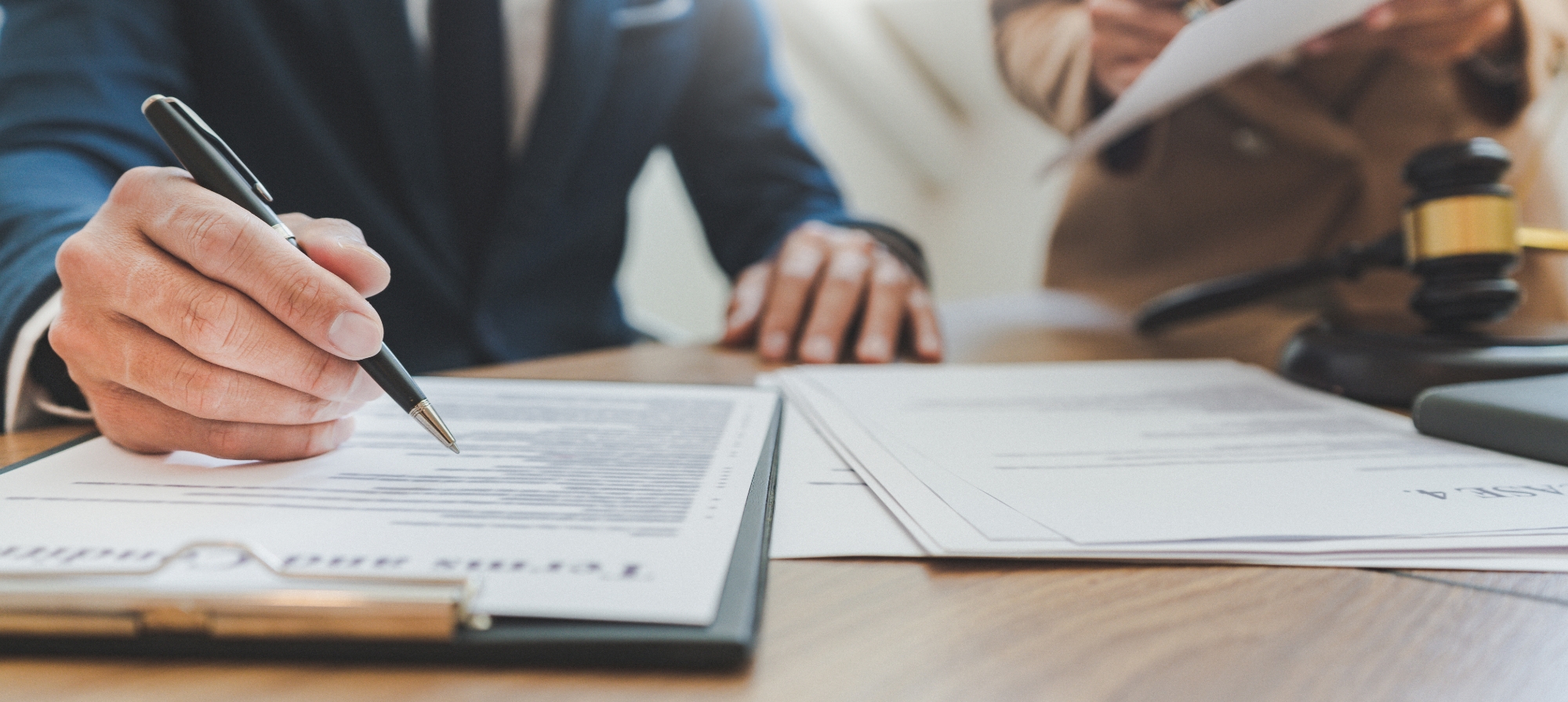“I’ll see you in court.”
It’s a dramatic statement, but what does it really mean? You’ve probably heard the phrase, but many people don’t really know what it means to “file suit.” You might know that it’s part of the personal injury claim process; but where does it fit in—and what does it involve?
This article explains what it means to file a lawsuit and how that process differs from filing an insurance claim. We also talk about a couple of the more common suit types.
What Is a Personal Injury Lawsuit?
When you file a lawsuit, you are asking the courts to get involved in your personal injury claim. Rather than trying to resolve your dispute with the at-fault driver and their insurance company on your own, you are asking a judge or jury to issue a decision.
This is a formal process that involves strict rules and procedures. You’ll need to file a series of documents, meet specific deadlines, and navigate the entire litigation process.
However, it’s just one step in a much longer process. Let’s explore personal injury claims and their timelines.
When you file a lawsuit, you are asking the courts to get involved in your personal injury claim. Rather than trying to resolve your dispute with the at-fault driver and their insurance company on your own, you are asking a judge or jury to issue a decision.
What’s the Difference Between a Personal Injury Claim and a Lawsuit?
Some people think “personal injury claim” and “lawsuit” have the same meaning. However, there are some differences between the two words. When someone’s actions injure you or someone you love, you have a personal injury claim and might be owed compensation for your losses.
In a nutshell, lawsuits and insurance claims differ in that:
- Insurance claims are typically made first and are a way of asking insurance companies to compensate for injuries and damages.
- Lawsuits are often filed when negotiations with insurers break down or when filing deadlines are approaching, and they carry the threat of a potential jury award.
Step 1: Prelitigation
After a car crash or another life-changing event, a personal injury lawyer will get to work quickly, collecting evidence, notifying the insurance companies, and starting to build out their clients’ legal claims. This process is called prelitigation.
During this time, your lawyer will investigate the people and entities involved, including their assets and potential liability. This can involve many activities:
- Acting quickly to preserve evidence, like dashcam footage, trucking logs, and cell phone records
- Analyzing your medical records, police reports, and all the crash data
- Consulting with expert witnesses, like doctors, accident reconstruction engineers, and economists
- Interviewing eyewitnesses
- Calculating all your economic and non-economic losses
- Finding every insurance policy that covers your damages, including the at-fault party’s liability insurance and your uninsured/underinsured motorist and personal injury protection policies
Armed with all this information, your personal injury attorney will negotiate with insurance adjusters, trying to resolve your claim without a lawsuit.
Of course, the insurance companies won’t always agree with your lawyer. If negotiations stall or the statute of limitations is expiring, it’s time to file suit.
If negotiations stall or the statute of limitations is expiring, it’s time to file suit.
Step 2: Litigation
Depending on the nature of your claims, you’ll need to file your lawsuits can in federal court or state court. Most, but not all, Texas personal injury claims are state court claims. To be filed in federal court, the suit must be related to federal law or the involved parties must be from different states.
When you file a lawsuit, you set out your legal claims in a document (called a complaint) and file it with a court. While you can drive to the courthouse and file a lawsuit in person, most lawyers file their documents electronically. Next, you will serve the complaint on the at-fault parties or defendants. Once the at-fault parties know about your lawsuit, they must respond within a certain time.
As soon as the at-fault parties file an answer to your complaint, litigation starts. Think of litigation as a process where you and the defendants share information, present your claims and defenses, and try to resolve your dispute.
Step 3: Mediation and Dispute Resolution
Settlement negotiations will continue even after you file a personal injury lawsuit. Many personal injury cases go through a dispute resolution process called mediation. During mediation, a trained, neutral professional will listen to both sides’ arguments and try to help them find common ground. It’s an effective process, and Crosley Law has successfully mediated record-breaking settlements.
However, if mediation is unsuccessful and the insurance company refuses to offer a fair settlement, your case will go to trial.
Step 4: Trial and Appeals
Personal injury trials are very formal and time-intensive proceedings. A jury will be selected, and then you and the insurance company will have a chance to present your evidence, including witnesses.
Once you’ve presented all the admissible evidence and your legal arguments, the jury will deliberate. Then, they will issue a decision either awarding or denying your request for compensation.
If either side disagrees with the jury’s verdict, they can file an appeal.
RELATED: The 3 Stages of Your Car Accident Lawsuit
What Are Your Chances of Winning a Personal Injury Lawsuit?
A trustworthy lawyer will never promise you a “win.” Every case is different, and your lawsuit’s strength will depend on the severity of your injuries, the facts surrounding your claim, and whether the insurance company has any defenses.
Juries and judges don’t always agree with our arguments, no matter how compelling they are. However, a good lawyer can do a lot to improve your chances of winning a personal injury lawsuit.
Most successful personal injury claims share the following elements:
- Significant evidence that documents the at-fault party’s negligence and your injuries. This typically includes expert testimony and detailed medical records
- Detailed calculations of your damages, which outline your medical expenses and needs, pain and suffering, and lost income, and other losses
- Carefully constructed litigation strategies that help frame your case for the insurance company and the jury
- Attention to detail, ensuring that you don’t miss deadlines, potential insurance coverage, or evidence that supports your claims
Managing a personal injury lawsuit takes a lot of time and expertise. Most injured people can’t manage all these details while also focusing on their recovery. That’s why they turn to a trusted injury law firm, like Crosley Law.
How You Can Strengthen Your Personal Injury Claim
While you probably don’t have existing relationships with expert witnesses or understand how to interpret a commercial vehicle’s GPS data, there are still things you can do to strengthen your injury claims.
First, get consistent medical care. Your medical records will be essential evidence, helping explain the severity of your injuries and linking them to the crash or incident. If you’re worried about how you’ll pay your medical bills, talk to your attorney. They can help you understand your options and might be able to negotiate with your medical providers.
Second, keep everything. Your lawyer will want to see the pictures you took at the crash site, those letters from the insurance company, and all your medical bills and receipts.
Finally, don’t wait too long to consult with an injury lawyer. It takes time to properly develop an injury claim and prepare for trial. And as time passes, evidence might get destroyed and memories will fade.
Plus, there’s very little risk when you call a lawyer. All reputable injury lawyers offer free consultations.
RELATED: How Much Do Accident Attorneys Cost?
Do You Need a Lawyer to File a Personal Injury Lawsuit?
While you can file a lawsuit on your own, it’s probably not in your best interests. Your top priority should be your physical and emotional recovery, not the nuanced details of Texas personal injury law.
You shouldn’t have to worry about answering interrogatories, responding to the defense lawyers’ motions, or negotiating a personal injury settlement when you’re hurt or grieving. Crosley Law’s team prides itself on its cutting-edge legal tactics and compassionate client experience. It’s our job to educate you about your legal rights, offer emotional support, and fight for the compensation and accountability you deserve.
Why do we invest so much time and effort into our clients’ cases? Because we believe that if you prepare every case as if it’s headed to trial and empower your clients, you’ll get better results.
RELATED: How Long Does It Take to Get Money After a Settlement?
Crosley Law: San Antonio’s Trusted Team of Personal Injury Lawyers
Every case comes with its own complexities, and if you’re thinking of filing a lawsuit it’s in your best interest to work with a lawyer who’s experience in the area of civil suits and personal injury.
The team at Crosley Law offers a free initial consultation where we can get to know you and your case. We’ll walk you through our process and resources, including working with medical experts and accident reconstruction engineers to help you get the compensation you deserve.
Call 210-LAW-3000 | 210-529-3000 or complete the simple contact form on our website.
The content provided here is for informational purposes only and should not be construed as legal advice on any subject.









